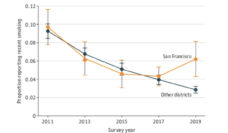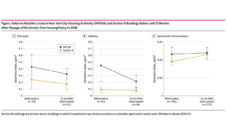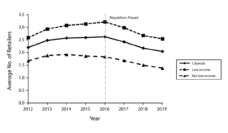Young adults exposed to tobacco marketing are more likely to start smoking, leading to nicotine addiction and increased risk for developing cancers and cardiovascular disease later in life. Policies that reduce advertising exposure to tobacco products, especially in vulnerable communities, will help address increased tobacco-related health disparities among communities of color, low-income populations, and youth.
We examined real-time marketing exposure among young adults who did not currently use tobacco residing in the Washington, D.C. area. The study found that young adults from vulnerable communities are more likely to be exposed to tobacco marketing in their daily lives than are young adults living elsewhere. These vulnerable communities are characterized by higher smoking rates, more residents of lower income, and more African American residents.
The results suggest that this association is even stronger for exposure to flavored tobacco product marketing.
Frequenting public places, such as retail stores, public transit, or restaurants and bars, may also increase odds of young adults’ exposure to tobacco and flavored tobacco marketing. Being in the presence of other people using tobacco is also a key risk factor for exposure to tobacco marketing. These results suggest that certain locations may serve as community “hotspots” where young people are frequently exposed to pro-tobacco messages, tobacco-use cues, and tobacco sales and promotion. For example, bars and restaurants that allow outdoor smoking may also have tobacco marketing. All of these social and environmental factors may shape young adults’ perceptions and behavior related to tobacco use.
Communities of color, low-income populations, and youth are already more likely to use flavored tobacco products — including menthol cigarettes — which are easier to start using and harder to quit. The outcomes align with the tobacco industry’s long history of targeting Black neighborhoods with menthol cigarette marketing, which is a cause of the tobacco-related health disparities seen in these communities.
We found that young adults were predominantly exposed to tobacco marketing in their daily lives through retail advertisements.
We found that young adults were predominantly exposed to tobacco marketing in their daily lives through retail advertisements. Exposure to these messages goes beyond tobacco specialty retailers to everyday places like grocery stores, gas stations or outdoor advertising. This pervasive marketing could increase the likelihood of developing pro-tobacco perceptions in young people in ways that normalize tobacco use.
Vulnerable communities can benefit from policies to reduce marketing exposure across a variety of retail establishments and exterior locations. For example, policy initiatives can focus on directly reducing the presence of tobacco marketing in retail settings, such as prohibiting the exterior display of tobacco advertisements through sign laws.
A larger strategy is to enact tobacco retailer density reduction strategies which limit tobacco retailer licenses over time. These types of strategies can reduce both marketing exposure and places to purchase tobacco in vulnerable communities. Additionally, strategies to restrict the sales of flavored tobacco products will likely curtail both flavored tobacco availability and marketing. This type of policy was recently enacted in Washington DC. Such policies can reduce the inequitable marketing of flavored tobacco products in lower income and Black communities.
Our findings can help community leaders create policies that protect young people from exposure to tobacco marketing in their daily lives. These policy strategies may also reduce tobacco-related disparities associated with tobacco use, given vulnerable communities’ differential exposure to tobacco and flavored tobacco marketing as found in this study.
Acknowledgment: This research, originally published in the Annals of Behavioral Medicine, is part of a larger study Rose is leading to examine tobacco marketing exposure of young adults. Julia Chen-Sankey was the first author. She is an assistant professor at the Center for Tobacco Studies and School of Public Health at Rutgers University.
Photo via Getty Images















